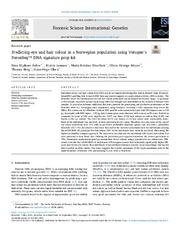Predicting eye and hair colour in a Norwegian population using Verogen’s ForenSeq™ DNA signature prep kit
Permanent lenke
https://hdl.handle.net/10037/26434Dato
2021-10-24Type
Journal articleTidsskriftartikkel
Peer reviewed
Forfatter
Salvo, Nina Mjølsnes; Janssen, Kirstin; Kirsebom, Maria Kristine; Meyer, Olivia Strunge; Berg, Thomas; Olsen, Gunn-HegeSammendrag
Prediction of eye and hair colour from DNA can be an important investigative tool in forensic cases if conventional DNA profiling fails to match DNA from any known suspects or cannot obtain a hit in a DNA database. The
HIrisPlex model for simultaneous eye and hair colour predictions was developed for forensic usage. To genotype
a DNA sample, massively parallel sequencing (MPS) has brought new possibilities to the analysis of forensic DNA
samples. As part of an in-house validation, this study presents the genotyping and predictive performance of the
HIrisPlex SNPs in a Norwegian study population, using Verogen’s ForenSeq™ DNA Signature Prep Kit on the
MiSeq FGx system and the HIrisPlex webtool. DNA-profiles were successfully typed with DNA input down to 125
pg. In samples with DNA input < 125 pg, false homozygotes were observed with as many as 92 reads. Prediction
accuracies in terms of AUC were high for red (0.97) and black (0.93) hair colours, as well as blue (0.85) and
brown (0.94) eye colours. The AUCs for blond (0.72) and brown (0.70) hair colour were considerably lower.
None of the individuals was predicted to have intermediate eye colour. Therefore, the error rates of the overall
eye colour predictions were 37% with no predictive probability threshold (pmax) and 26% with a probability
threshold of 0.7. We also observed that more than half of the incorrect predictions were for individuals carrying
the rs12913832 GG genotype. For hair colour, 65% of the individuals were correctly predicted when using the
highest probability category approach. The main error was observed for individuals with brown hair colour that
were predicted to have blond hair. Utilising the prediction guide approach increased the correct predictions to
75%. Assessment of phenotype-genotype associations of eye colours using a quantitative eye colour score (PIEscore), revealed that rs12913832 AA individuals of Norwegian descent had statistically significantly higher PIEscore (less brown eye colour) than individuals of non-northern European descent. To our knowledge, this has not
been reported in other studies. Our study suggests that careful assessment of the target population prior to the
implementation of forensic DNA phenotyping to case work is beneficial.
Er en del av
Salvo, N.M. (2024). Forensic DNA phenotyping - Towards reliable and accurate DNA tests for prediction of eye colour, hair colour and biogeographical ancestry. (Doctoral thesis). https://hdl.handle.net/10037/33807Forlag
ElsevierSitering
Salvo, Janssen, Kirsebom, Meyer, Berg, Olsen. Predicting eye and hair colour in a Norwegian population using Verogen’s ForenSeq™ DNA signature prep kit. Forensic Science International: Genetics. 2022Metadata
Vis full innførselSamlinger
Copyright 2021 The Author(s)


 English
English norsk
norsk